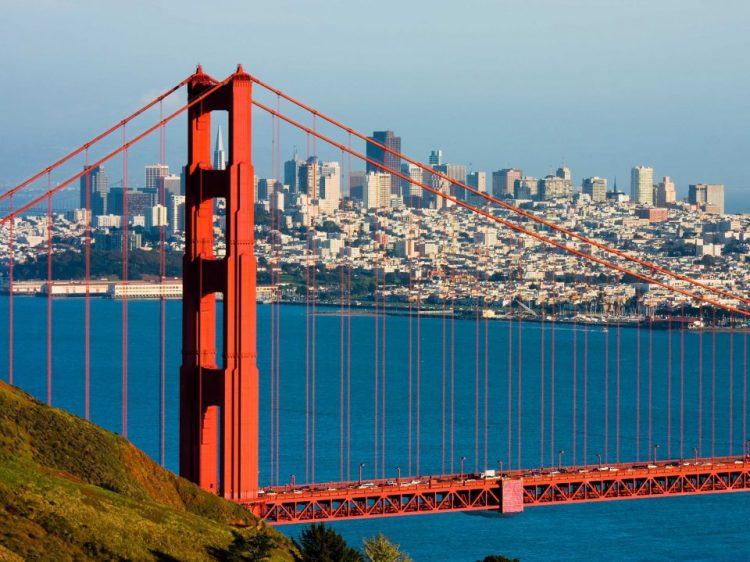
Many people think of San Francisco as an ultra-liberal nanny town. On the contrary, as I found on a recent visit, it’s above all a place that resents government and welcomes contrarians.
In the waters of San Francisco Bay, an entrepreneur named Forbes Kazoo built his own island in 1980 and, below the waterline within that atoll, constructed his living quarters. This island-building Captain Nemo now operates his rock as a gourmet restaurant that’s accessible only by his private launch.
Dining at Forbes Island is like eating in the captain’s quarters of a pirate ship, and the food is first-class French cuisine. Above the underwater dining room is a 40-foot-high lighthouse with spectacular views.
This is quintessential San Francisco: a privately made extrusion that would be barred by other cities’ building codes and zoning laws. To me, it illustrates the extreme libertarianism that characterizes San Francisco’s identity.
San Franciscans go their own, independent ways. Sure, most of its citizens oppose government intrusion into sexual conduct, abortion and drug use. But they also champion free enterprise, no matter how crazy some of those enterprises may be.
While some East Coast cities stop and frisk men on sidewalks, San Francisco police do nothing to deter aggressive panhandlers on downtown streets. When I inquired, I was told that people have a civil liberty to do virtually whatever they like on public property.
The Embarcadero, fronting the bay, is now one of San Francisco’s most bustling areas. Although it’s as touristy as Times Square, I saw no visible police presence the first day I was there. The next day I saw one cop and I asked him about this. “Oh, I was off yesterday,” he replied, “and there was no one to replace me.” Yet amazingly, with only one cop there is hardly any pickpocketing, purse snatching or shoplifting.
Fronting the Embarcadero is Pier 39, a commercial shopping pier and amusement park filled with national chain restaurants. Yet the Embarcadero’s prime location, at the far end of the pier, houses a locally owned-and-operated restaurant, Hana Zen, that serves the best Japanese food I’ve ever had along with superb sunset views of the bay and its bridges.
Similarly, where else but in San Francisco would you find four competing independent tour-bus operators, all using red double-deckers and all loading at one place, Union Square in the heart of the city? In most towns, officials would seek bids to award a monopoly to the highest bidder.
The city’s freewheeling nature traces is a legacy of the Gold Rush of 1849. San Francisco grew from a small settlement of 200 residents in 1846 to an anarchic boomtown without any law regarding property rights, and no taxes. Many prospectors came by ship from South America and Asia. Enslavement and trafficking in Native American and Chinese labor was common.
After the Gold Rush, San Francisco declined into a ghost town. Abandoned ships were piled up in the water to serve as risky underpinning for landfill onto which the city subsequently expanded.
From gold miners to oil-drillers to dot-com entrepreneurs, the area became a haven for people trying to get rich quickly, the exact opposite of the penny-a-day prescription of Benjamin Franklin from Boston and Philadelphia.
San Franciscans demonstrated their audacity in 1939 when they opened a world’s fair in direct competition with the famous New York World’s Fair. Their version was called the Golden Gate International Exposition and it celebrated the openings of the Golden Gate Bridge and the Oakland-San Francisco Bay Bridge. The San Francisco designers blended Mayan, Incan, Malayan and Asian colors and architecture to honor the cultures of the Pacific Rim.
In the 1960s, of course, San Francisco welcomed hippies and gays when the rest of the country shunned them. A few kids can still be seen flashing themselves and giving peace signs to passing tour buses in Haight-Ashbury, while gays go about their own activities without ostentation in the blocks around the Castro movie theater.
This independence of enterprise extends to the arts. During my recent visit, the San Francisco Symphony, under Michael Tilson Thomas, presented a Beethoven Festival with unlikely compositions like Three Equali for Four Trombones, his Sonatina for Mandolin and Fortepiano, Cantata on the Death of the Emperor Joseph II, his song-cycle An die ferne Geliebte and a piece by John Adams, Absolute Jest, based on Beethoven themes. This is unorthodox programming taken to a delicious extreme.